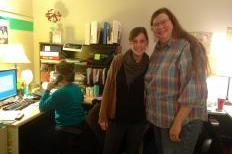







When families enroll their children at any Madison public school, they have the option of filling out a confidential form that will label them as homeless.
If families are staying at a shelter, there’s a box to check. If they’re temporarily living in a motel due to loss of housing, there’s a box to check. There’s also a box to check if families are living in a car, park, campground or abandoned building. Unaccompanied youth have their own box to mark.
More and more families are filling out this form because the number of students within the Madison Metropolitan School District without a place to sleep is increasing. The Education for Homeless Children and Youth (EHYC) reported 1,275 students were homeless in the 2012-2013 school year, up from 1,168 the year before.
“The largest growing portion of the homeless population is families with children,” Jani Koester, a resource teacher with the school district’s Transition Education Program, said.
TEP is a program through the school district that provides services to homeless families to ensure students with what the McKinney-Vento Homeless Assistance Act defines as “fixed, regular and adequate nighttime residence” are able to remain in school.
Koester said the reasons behind the increase number of homeless students and families is two-fold. First, TEP has improved at identifying homeless students by providing ways for parents to self-identify during school enrollment. The second reason is the housing market and access to affordable housing.
“A landlord’s market”
Families are experiencing increasing difficulty finding permanent shelter because of Madison’s landlord-friendly housing market and past changes in tenant and landlord laws.
Anders Zanichkowsky, a program director at the Tenant Resource Center, said a healthy vacancy rate, the percentage of all available rental units, is about 8 percent.
The vacancy rate is measured by calculating the percentage of apartments in Madison Gas and Electric’s service area that appear to be vacant because of inactive electric service or if the service has been moved to the owner’s name. In its 2014 third quarter measurements, MGE reported a 2.83 precent vacancy rate. In 2013, the rate fluctuated between 1.88 and 2.73 percent.
“The economic wisdom is that anything below 6 percent is a landlord’s market,” Zanichkowsky said. “We have an extreme landlord’s market.”
Zanichkowsky said many lower, middle-class homeowners, those “low on the totem-pole” of owning, are now
“When you get richer renters, the poor tenants get squeezed out into homelessness,” Zanichkowsky.
Recent changes to the city’s tenant and landlord laws also make renting difficult for families who are currently homeless, Zanichkowsky said. Some of these changes include the ability of landlords to charge as much as they want for a security deposit.
Waiting lists and longterm solutions
More families are becoming homeless, and at the same time, it is becoming more difficult to find affordable housing.
Kristen Rucinski, the executive director of the Road Home, has noticed that families are taking much longer to acquire permanent and affordable housing.
The Road Home is a Madison-based organization that is committed to relieving the immediate crisis of homelessness and provide resources for longer-term solutions, according to its website. The organization exclusively focuses on families and children.
The organization first opened in 1989 to serve as an overflow shelter for the Salvation Army or the YWCA but has expanded its services as the city’s need for them has grown, Rucinski said.
“The overflow isn’t really an overflow anymore,” Rucinski said. “We’re sort of the third shelter.”
Madison’s extremely low vacancy rate has resulted in families staying in the shelter system longer. Families used to take around 50 days to get out of the shelter system whereas now that time frame is between 70 and 80 days, Rucinski said.
“People are kind of getting backlogged in the system because it’s hard to get housing, and I think that’s why it seems like there’s even more of an increase because everything is taking longer and everything is backlogged,” Rucinski said.
The timeline has also extended for families in a two-year transitional housing program. Rucinski estimated that a few years ago, a family attempting to move into subsidized, or permanent, housing from transitional housing would be over 90 percent.
Now, waiting lists for subsidized housing are three, four or five years long, meaning that a family at the end of their two-year housing program would be left with nowhere to go, Rucinski said.
Despite these bleak statistics, the Road Home is able to assist about 150 families, Rucinski said, and over 93 percent of families maintained housing at the one-year mark.
“We don’t keep seeing the same faces over and over, which is good,” Rucinski said.
With over nine years of experience at the Road Home and providing services to Madison’s homeless families, Rucinski said the answer to homelessness is more affordable housing. The Road Home works with families with about 0 to 30 percent of the area’s median income, and affordable housing means between $200 and $400 dollars a month.
“If money was just falling from the sky, I’d put it all into creating more affordable housing,” Rucinski said.
“Unavailable for learning”
From living in cars to doubled-up at family or friend’s houses to motor homes, schools are faced with the reality
Students from 20 families are enrolled this year at Sherman Middle School, the school’s social worker Julie Wilke said.
“It makes kids unavailable for learning, and it causes them … in a lot of ways to have to grow up and be confronted with more adult issues than other kids,” Wilke said.
When Wilke first began working at Sherman in the fall of 1992, she dealt with academic struggles, attendance problems and behavior issues. Her role as an in-school social worker has transitioned to focusing on homelessness students and families. Wilke has become familiar with area food pantries and knows how to direct families to resources for the homeless.
Sherman provides services such as a clothes closet for students and families to access if the need arises. The school also provides free breakfast and lunch made possible through grant funding. The school also fosters a sense of community through its team-teaching approach, a system of larger class sizes with more teachers that are together for two years, which lets teachers invest in the lives of their students, Wilke said.
Wilke said she communicates confidentially to teachers if particular students are struggling with challenges related to housing and homelessness, and teachers will approach Wilke if they are noticing a student may be in need.
But students still come to school hungry. They continue to worry about money, where they will sleep that night, how to navigate a new bus route because they moved yet again. Children are confronted with adult issues before they’ve made it through middle school.
“They’re clobbered in a lot of ways,” Wilke said.
Wilke said she and teachers try to be available for the students, support them and keep them in the classroom, which may be one of the most stable aspects of a homeless student’s life.
Dreaming of a home
Despite the efforts of schools and willing organizations, there are families that go unserved. When looking at low vacancy rates and increasing number of unhoused students, the problem of homelessness can seem too big.
Rucinski at the Road Home addresses the problem one family at a time and uses unmet needs of the community as motivation to keep moving forward.
“When you have to turn a family away due to lack of capacity, it kind of drives you to figure out how are we going to increase affordable housing,” Rucinski said. “As much as the successes keep you going, the ones that you can’t serve are what really keep me going and coming to work each day to figure out what we can do as an agency and as a community to figure out this larger issue.”
Koester said while there is much frustration and sadness addressing homelessness issues, there is joy.
“When a family does get housing, when a child does receive a pair of snow pants, when a kid finally gets the assignment, when I see grades rising because a teacher has taken an interest in them those things… I celebrate those really wonderful pieces,” Koester said.
Homeless advocates like Rucinski and Koester do what they can for families in need, but they can’t provide everything for students who do not know where they’re sleeping at night.
“They have a home that they dream about,” Koester said. “I can’t produce that for them.”
|
|
|
Welcome to the Madison Commons, a website designed to provide news and information about all of Madison's neighborhoods and a crossroads for the discussion of community issues. The name comes from the idea of a village commons, a place for news, talk, debate, and some entertainment, too, that's open to everyone.
All rights reserved. Read more about the Madison Commons and its partners.

